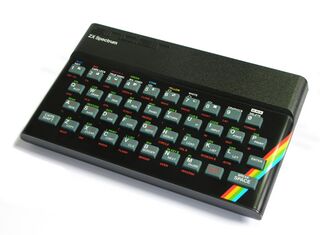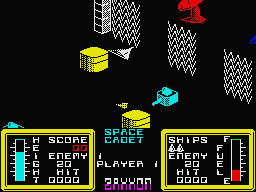Difference between revisions of "ZX Spectrum"
From Sega Retro
(Created page with "{{ConsoleBob | logos= | consoleimage=ZXSpectrum.jpg | imgwidth= | name= | maker=Sinclair Research | distributor= | variants= | add-ons= }} <section begin=intro />The '''{{PAGE...") |
|||
| Line 23: | Line 23: | ||
All Sega games function to some degree with the Spectrum's built-in keyboard - while joysticks were widespread, unlike other popular microcomputers no agreed standard was put forward for controller interfaces, meaning games were often forced to support multiple standards. | All Sega games function to some degree with the Spectrum's built-in keyboard - while joysticks were widespread, unlike other popular microcomputers no agreed standard was put forward for controller interfaces, meaning games were often forced to support multiple standards. | ||
| − | Despite its name, the Spectrum has very limited graphical capabilites in comparison to other machines. Out of the computer's palette of eight colours, only two can occupy an 8x8 pixel square at any one time, meaning for games this can frequently lead to "colour clash", with graphics appearing to "bleed" into one another. To mitigate this problem it was common to see Spectrum games run in monochrome, although some (notably the Spectrum port of ''[[Altered Beast (home computers)|Altered Beast]]'') attempt to use colour with varying degrees of success. | + | Despite its name, the Spectrum has very limited graphical capabilites in comparison to other machines. Out of the computer's palette of eight colours (doubled if taking into account the two brightness settings), only two can occupy an 8x8 pixel square at any one time, meaning for games this can frequently lead to "colour clash", with graphics appearing to "bleed" into one another. To mitigate this problem it was common to see Spectrum games run in monochrome, although some (notably the Spectrum port of ''[[Altered Beast (home computers)|Altered Beast]]'') attempt to use colour with varying degrees of success. |
While the age of the machine would suggest Spectrum ports would fare the worst out of the 8-bit home computer conversions, often the opposite is true, with the Spectrum's Z80 CPU outperforming the Commodore 64's 6501 in many situations. Meanwhile Amstrad CPC and MSX games were often quickly ported from the Spectrum, failing to tap into the specific strengths of each machine, and often performing worse than the Spectrum originals as a result. | While the age of the machine would suggest Spectrum ports would fare the worst out of the 8-bit home computer conversions, often the opposite is true, with the Spectrum's Z80 CPU outperforming the Commodore 64's 6501 in many situations. Meanwhile Amstrad CPC and MSX games were often quickly ported from the Spectrum, failing to tap into the specific strengths of each machine, and often performing worse than the Spectrum originals as a result. | ||
Revision as of 05:53, 14 April 2017

|
| ZX Spectrum |
|---|
| Manufacturer: Sinclair Research |
The ZX Spectrum is an 8-bit home microcomputer released by Sinclair Research in 1982 as a successor the the ZX81 and ZX80.
The Spectrum was the most successful home computer in the United Kingdom (where it was predominantly sold) for most of the 1980s, with over five million units sold (likely rising much higher if Spectrum hardware clones are taken into account). Over 24,000 software titles have been released for the platform.
Sega support
Like all home computers prior the rise of IBM PC compatibles running Windows 95 (and excluding the Sega-designed SC-3000), Sega did not bring any of its games to the ZX Spectrum directly, instead licensing out arcade properties to the likes of Activision (Mediagenic) and U.S. Gold, which would in turn sub-license development work to smaller studios. While the Spectrum lacked the global reach of the Commodore 64, its popularity in the UK (and other markets such as Spain) meant it was difficult to ignore, and was supported with Sega titles between 1985 and 1992.
As with its 8-bit rivals, the Amstrad CPC, Commodore 64 and MSX line, support continued for the Spectrum alongside the more powerful 16-bit machines of the late 1980s; the Atari ST and Amiga. All games were distributed on compact cassette, while many also appeared on the 3-inch floppy disk format, brought about by Amstrad's release of the ZX Spectrum +3 model.
Over the course of its life, Spectrums were produced in 16kB, 48kB and 128kB models, the former being discontinued around 1984. All Sega games published for the Spectrum (as was the case with the vast majority of the library) are compatible with 48kB models, though some can tap into the 128kB machines for extra features (accessing the AY-3-8910 sound chip for music being a common option).
All Sega games function to some degree with the Spectrum's built-in keyboard - while joysticks were widespread, unlike other popular microcomputers no agreed standard was put forward for controller interfaces, meaning games were often forced to support multiple standards.
Despite its name, the Spectrum has very limited graphical capabilites in comparison to other machines. Out of the computer's palette of eight colours (doubled if taking into account the two brightness settings), only two can occupy an 8x8 pixel square at any one time, meaning for games this can frequently lead to "colour clash", with graphics appearing to "bleed" into one another. To mitigate this problem it was common to see Spectrum games run in monochrome, although some (notably the Spectrum port of Altered Beast) attempt to use colour with varying degrees of success.
While the age of the machine would suggest Spectrum ports would fare the worst out of the 8-bit home computer conversions, often the opposite is true, with the Spectrum's Z80 CPU outperforming the Commodore 64's 6501 in many situations. Meanwhile Amstrad CPC and MSX games were often quickly ported from the Spectrum, failing to tap into the specific strengths of each machine, and often performing worse than the Spectrum originals as a result.
With U.S. Gold and Activision trending towards arcade conversions, Spectrum ports, despite being designed for much simpler hardware, are often more accurate than their Sega Master System counterparts, which were typically tailored (and often simplified) for the home market (Enduro Racer and Line of Fire being prime examples). Spectrum games were also retailed significantly cheaper - around £10-£15 on release (versus £40 on a Master System cartridge), and dropping to as low as £2.99 when re-released in budget lines some months later.
List of Sega games for the ZX Spectrum
- Zaxxon (1985)
- Buck Rogers: Planet of Zoom (1985)
- Spy Hunter (1985)
- Tapper (1985)
- Space Harrier (1986)
- Enduro Racer (1987)
- Quartet (1987)
- Wonder Boy (1987)
- OutRun (1987)
- Super Hang-On (1987)
- Desolator (1988)
- After Burner (1988)
- Passing Shot (1988)
- SDI: Strategic Defense Initiative (1988)
- Thunder Blade (1988)
- Alien Syndrome (1988)
- Action Fighter (1989)
- Time Scanner (1989)
- Turbo OutRun (1989)
- Dynamite Dux (1989)
- Scramble Spirits (1989)
- Super Wonder Boy (1989)
- Shinobi (1989)
- Altered Beast (1989)
- Power Drift (1989)
- Galaxy Force II (1990)
- Hot-Rod (1990)
- Sonic Boom (1990)
- Space Harrier II (1990)
- Crack Down (1990)
- Cyber Police ESWAT (1990)
- Golden Axe (1990)
- Line of Fire (1990)
- World Championship Soccer (1990)
- Super Monaco GP (1991)
- Shadow Dancer (1991)
- Alien Storm (1991)
- Bonanza Bros. (1991)
- G-LOC: Air Battle (1992)
Compilations
- The Sega Collection (198x)
- Sega Master Mix (1990)
- Wheels of Fire (1990)
- Super Sega (1991)
- G-LOC/OutRun Europa (199x)
